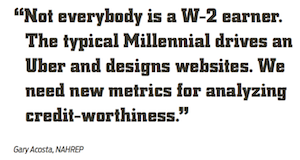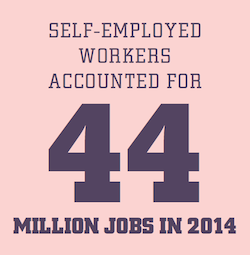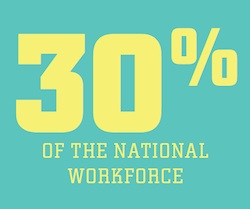While the average American homebuyer is still a W-2 income earner with a FICO score, more and more borrowers fail to fit that mold, just as many banks are becoming increasingly leery of manual underwriting. What are the options for this growing population of nontraditional borrowers?
Jean Parker of Rockledge, Florida, has been self-employed since 1985, and has had a long and successful career as a therapist. She has owned homes in her own name since as far back as 1990. But three years ago, when she wanted to purchase the home in which she now lives, she couldn’t get a mortgage for a residence in a neighborhood “where I wouldn’t be scared to go out at night,” she said. Never mind that she had a credit score of 700.
But she also had multiple self-employed income sources as a part-time therapist, Tai Chi instructor, and home health companion. Not exactly the kind of employment data a traditional home lender wants to see, especially these days when so much of lending is about meeting the rules for a Qualified Mortgage. “Gone are the days when you sit down with a person who knows you,” Parker said.
But the longtime career woman took matters into her own hands and worked out an agreement with her personal accountant. He bought the house Parker wanted to purchase and rented it to her for the cost of the monthly mortgage payments, taxes and insurance for a year.
Twelve months later, she purchased the house using financing from Navy Federal Credit Union and a Federal Housing Administration (FHA) loan.
It took her a couple of months to get through the loan process, and she admits deep frustration with the experience. “I have always been careful about recording my income,” she said. “If I was making a Lexus income, then I wanted to be driving a Lexus.”
THE FACE OF THE NEW AMERICAN BORROWER
Though Parker identifies as a Baby Boomer, her situation is no longer as unique as it was when she started her career more than three decades ago. According to a Pew Research Center analysis of U.S. Census Bureau data, self-employed Americans and the workers they hired accounted for 44 million jobs in 2014, which is 30% of the national workforce.
Nontraditional income earners are becoming increasingly mainstream, particularly among Millennials, who, compared to their parents and grandparents, move from job to job a lot more, are more likely to be independent contractors, and may lack a solid credit profile.
Take classical musicians Matthew and Megan Beaumont, for example. The couple, in their mid-30s, bought their first home in Bogota, New Jersey, a year ago, but because both are self-employed, they went through what Matthew calls “a slew of hoops” to get a mortgage loan.
While the couple used a traditional mortgage lender to finance their home purchase, Matthew said, “We definitely had to provide a lot more documentation than your average borrower, such as profit and loss statements for all of our businesses (not something we would typically generate for a single-member business), and the [bank] wanted an explanation for many of our larger bank deposits in the months leading up to closing, which included some wedding gifts.”
Matthew feels that lenders use an employee-first model as the norm for determining loan qualifications, and then attempt to make self-employed individuals justify themselves inside of that framework.
“It would be great to see lawmakers and regulators acknowledge that there really are [different] ways of earning a living in this country, and to adjust their thinking accordingly,” he said.
The overall face of the American homebuyer is changing from the traditional W-2 income earner to 1099 contractors, small business owners, buyers with no credit history or profile even though they have strong finances, recent immigrants, and an array of other profiles that can’t be easily boxed into the traditional 43% debt-to-income ratio rule.
According to a recent study by the Institute for Corporate Productivity, 95% of HR executives interviewed anticipate using more nontraditional (i.e. non-employee) workers in the coming years than ever before. Institute CEO Kevin Oakes said the rise of Uber is a key example of a “growing nontraditional labor force, as well as changing ideas and attitudes about both the implicit and explicit employer-employee contract.”
According to a 2015 report from the Government Accountability Office titled “Contingent Workforce: Size, Characteristics, Earnings and Benefits,” workers who receive 1099s (as opposed to W-2s) make up 12% of the U.S. workforce. Those 1099 workers include both the self-employed and independent contractors.
Rod Griffin, director of public education for Experian, said he doesn’t believe financing has become any more difficult for nontraditional workers to obtain than in the past. “That segment of the population always tends to have more challenges,” he noted. “Lenders like to see consistency. That’s more important than credit history.”
He added that the heavily streamlined approach many traditional lenders take to qualifying mortgage loans makes it more difficult for borrowers like Parker and the Beaumonts to qualify for loans, but GSEs Fannie Mae and Freddie Mac are driving a big part of the mortgage market, and they don’t guarantee many loans that fall outside the strictures of the Qualified Mortgage rule.
Which means that nontraditional borrowers and the lenders who want to write mortgages for them have to get creative.
LENDERS EMBRACING THE CHALLENGE
Among the niche lenders serving nontraditional buyers, the nation’s Farm Credit system, which turns 100 this year, is a stalwart. As of the close of the first quarter of 2016, the gross loan volume for the Farm Credit system stood at $238.4 billion. Farm Credit has long provided a hedge for farmers and rural landowners and homeowners who don’t fit cookie-cutter loan models.
Prior to the creation of the Farm Credit system in 1916, “farmers had no good sources of mortgage loans,” says James Putnam, chief business officer for Farm Credit East.
Today the 80 Farm Credit agencies across the country are independent cooperatives that return profits to members/owners in the form of patronage refund checks. Interestingly, despite the agencies’ focus on what traditional banks consider “high-risk” mortgage loans, Putnam points out that Farm Credit agencies came through the Great Recession with flying colors. “They had the best capitalization of any banks in the U.S.,” he said.
But borrowers don’t have to be a farmer or rural landowner to take advantage of similarly poised credit unions. Because they are mem ber-owned, credit unions often provide more personalized service and manual underwriting for nontraditional borrowers. According to Credit Union National Association Mutual Group, consumer use of credit union loans is on the rise. In 2015, credit unions originated more than 8% of mortgage loans, almost double the amount they serviced in 2010.
 Other niche lenders are accommodating nontraditional borrowers by evaluating different documentation than the standard W-2. Citadel Servicing Corp., based in Irvine, California, created a loan program four years ago that allows self-employed borrowers to document their income using bank statements instead of tax returns like 1040s or 1099s.
Other niche lenders are accommodating nontraditional borrowers by evaluating different documentation than the standard W-2. Citadel Servicing Corp., based in Irvine, California, created a loan program four years ago that allows self-employed borrowers to document their income using bank statements instead of tax returns like 1040s or 1099s.
The company requires two years of bank statements to validate cash flow, which gives it insight into a borrower’s ability to repay.
“We believe that 24 months of continuous bank statements are a very reliable look into what a person actually lives on per month when compared to tax returns or even a W-2,” said Will Fisher, senior vice president of sales and marketing at CSC.
“Because these borrowers are self-employed, they want the benefits that come with the legal ability to write off expenses. That can make the use of tax returns as conventionally underwritten a poor barometer of ability to repay, but we’re able to document income in a different way.”
CSC offers up to 90% LTV for self-employed borrowers with a 700 credit score and up to 80% LTV for a credit score of 600 or higher. CSC addresses risk on the front-end through its underwriting process but also services its own loans, which gives the company every incentive to fund high-quality loans. As the servicer, CSC has a window into how the loans are performing, which helps them adjust origination program guidelines accordingly.
A FURTHER COMPLICATION
As if things aren’t tricky enough for nontraditional workers, add onto that being a recent immigrant, and the chances of qualifying for a home mortgage are even smaller. Last fall The New Yorker published a story called “The Accused” about Abacus Federal Savings Bank in New York’s Chinatown.
The bank has developed a niche market serving the immigrant community, whose members are sometimes undocumented and tend to operate their lives on a cash basis. In 2010, the bank came under legal scrutiny for allegedly falsifying loan documents, despite the fact Abacus had a home mortgage delinquency rate less than a 20th of the national average.
While the bank was acquitted of any wrongdoing in Manhattan Criminal Court last fall, the case brought to light cultural differences that can limit nontraditional borrowers’ access to credit from institutions outside small community banks. For example, many Asian immigrants receive “loans” from family to make down payments for a home purchase. The GSEs, which back about 60% of U.S. home loans, don’t permit this practice, but in Chinese culture, for example, a loan from a family member is really like a gift. There is no expectation of payback if the recipient party cannot afford to pay.
“Credit continues to be a huge problem for immigrants who have come to this country in the last five years,” said Hope Atul, executive director of the Asian Real Estate Association of America (AREAA). “It’s not that they have bad credit, just no credit.” And then many Asian immigrants are also business owners, which makes it more difficult for lenders to verify income information.
The AREAA is among groups lobbying for passage of H.R.4211, which supports establishment of an alternative credit rating system designed to make home ownership more accessible to immigrants and other potential homebuyers lacking solid FICO scores or FICO scores at all.
Gary Acosta, CEO of the National Association of Hispanic Real Estate Professionals, said lenders need to update the way they underwrite loans. “People earn money in nontraditional ways,” he said. “Not everybody is a W-2 earner. The typical Millennial drives an Uber and designs websites. We need new metrics for analyzing credit-worthiness.”
And while credit reporting agencies, like Experian, will accept payment history reporting from landlords and utilities, many companies don’t report this information, and that’s even more likely the case if, for example, a borrower is living in a house or apartment rented out by an individual.
Some banks also offer FHA-guaranteed loans for borrowers lacking traditional credit histories, though these loans still require a debt-to-income ratio of 43%, a sound history of timely payments on things like rent and utilities, as well as enough cash reserves for a month’s worth of expenses post-home purchase. But if you’re unable to meet a 20% down payment, you will have to pay mortgage insurance.
Dowell Myers, Ph.D., professor of policy, planning, and demography at the University of Southern California, said the lack of loan sources for nontraditional borrowers is actually hurting economic recovery. “If we can’t tap the economic resources of all the 1099 people, who is going to buy all the houses on the market?” he asked. “In general, lenders are not used to evaluating special categories.”
EXPANDING DEFINITIONS OF “ABILITY TO REPAY”
Carol Galante, who served as Federal Housing Administration (FHA) commissioner from 2011 through 2014, knows a lot about the financing challenges faced by so many of today’s borrowers and not just from her time in Washington, D.C., serving in one of the most scrutinized roles in housing policy post-recession.
Galante’s concerns about her home state of California’s ongoing housing issues are a big part of the reason she chose to serve as faculty director of the Terner Center for Housing Innovation at the University of California-Berkeley when she came home from Washington.
Among the many ideas Galante is working on as a member of the Terner Center is how to scale a lease-to-own model, not unlike the model borrower Jean Parker used informally, only she’d like to see that model launch as an official program or private sector initiative on a large scale.
“We know of one company that helps people find homes they want to purchase but don’t have the credit for doing so,” she explained. “In these cases, the bank purchases the home, leases it to the borrowers, and then sells it to the borrower once they’ve established good credit.”
She said the center is also evaluating models where a homeowner and an investor share the down payment. Ultimately, Galante points out, this isn’t so unlike Fannie Mae’s new HomeReady mortgage program for nontraditional households, where income from non-borrower household members can be part of the equation for evaluating readiness for home ownership and creditworthiness. That might include income from an older working parent living in the household or rental income from a basement apartment, for example.
Of course, any radical change that addresses the quickly morphing demographic of the average American homebuyer will likely require bipartisan legislative action. “One of the things I learned [as FHA commissioner] is that making change through legislative processes is very, very difficult,” Galante noted. “But when you can make a legislative change at a high level, it has major impact in a way nothing else can.”
For now, the options for nontraditional borrowers remain somewhat limited, and the best advice Experian’s Griffin can offer is to work on building a responsible credit history. “We don’t want to ease lending standards,” he said. “It’s more about identifying people who are reliable credit risks, so we can expand the definition of who is credit-worthy.”
As for nontraditional borrowers like Parker and the Beaumonts, they see a real opportunity for lenders willing to take up the cause of a niche market. “If there was a mortgage company that catered to self-employed women,” Parker remarked, “they’d do a booming business.”





